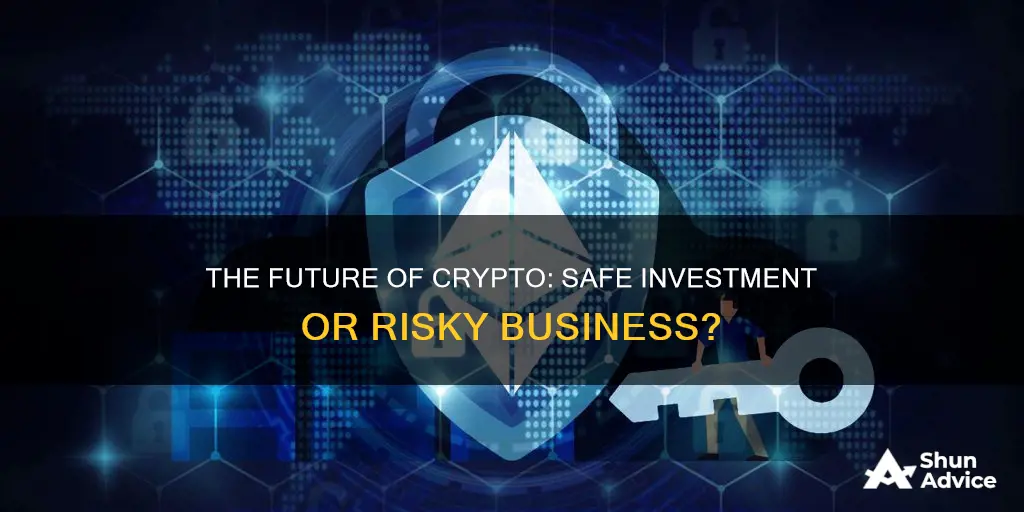
Investing in cryptocurrency is risky due to its volatile nature. Crypto is prone to roller-coaster fluctuations in price, and there is a non-zero chance of any crypto asset plummeting in value in a single day. Crypto is also susceptible to scams and fraud. However, it can be a good investment for those who can tolerate the risk and are financially prepared to lose everything invested.
| Characteristics | Values |
|---|---|
| Volatility | High |
| Accessibility | High |
| Regulatory uncertainty | High |
| Security | High |
| Decentralization | High |
| Transaction speed | High |
| Transaction fees | Low |
| Criminal activity | High |
What You'll Learn

Crypto's extreme volatility
Cryptos Extreme Volatility
Cryptocurrency is an extremely volatile asset class, prone to roller-coaster fluctuations in price. This volatility is driven by various factors, including news developments, speculation, and the lack of liquidity in crypto markets compared to traditional financial markets.
News Developments and Speculation
News and speculation have a significant impact on crypto prices. For example, the approval of spot Bitcoin ETFs in 2024, which allowed mainstream investors to track Bitcoin's performance without directly owning it, contributed to a surge in Bitcoin's price. Similarly, the Bitcoin halving event in April 2024, where mining rewards were cut in half, has historically led to rallies in Bitcoin's price within 18 months.
Liquidity and Institutional Investment
Crypto markets have less liquidity than traditional financial markets due to the absence of a robust ecosystem of institutional investors and large trading firms. This lack of liquidity, combined with heightened volatility, creates a dangerous combination as they feed off each other. However, there are signs that this may be changing, with institutional investors and trading firms entering the crypto asset class more decisively.
Derivatives Market
Another factor contributing to crypto volatility is the underdeveloped derivatives market for most cryptocurrencies, excluding Bitcoin. Derivatives markets can help stabilize prices and provide additional investment options for risk management.
Investor Sentiment and Macroeconomic Factors
Investor sentiment and macroeconomic factors also play a role in crypto volatility. Crypto, being a relatively new asset class, is more prone to huge price swings as investors may not know exactly what to make of it. Additionally, factors such as rising inflation and interest rate hikes can significantly impact crypto prices, as seen in 2022 when the crypto market lost over half its value.
Market Capitalization
The behavior of cryptocurrencies can also vary based on their market capitalization. For instance, Bitcoin and Ether, the two largest cryptocurrencies by market cap, have exhibited different volatility patterns compared to other coins with lower market caps, such as Litecoin and XRP.
Asymmetric Volatility
Some studies have also found evidence of asymmetric volatility in cryptocurrencies, where negative news has a more significant impact on price volatility than positive news. This behavior is similar to that seen in stock markets, where negative news tends to increase volatility.
Spillover Effects
Lastly, there is a strong spillover effect among different cryptocurrencies, meaning that volatility in one crypto can impact the volatility of others. This is particularly true for cryptocurrencies with high market capitalization, such as Bitcoin and Ether.
Understanding Crypto: A Prerequisite to Investing?
You may want to see also

Regulatory uncertainties
The regulatory landscape for cryptocurrencies is evolving, with many world governments weighing how to react to the rise of crypto. This includes shifting regulations that may impact crypto's volatility. For example, the US SEC's actions against crypto exchanges and lending offerings have created a sense of regulatory uncertainty.
The regulatory environment also influences investor confidence. Uncertainty about government policies can cause investors to lose confidence in their fiduciary currency and re-examine their portfolios. This dynamic has been observed in the stock market, and similar behaviour may be expected in the crypto market.
The regulatory treatment of cryptocurrencies varies across jurisdictions. For instance, while crypto is generally seen as legal across Europe, it is less regulated than many other asset classes. In contrast, China has taken a more restrictive approach, as seen in its crackdown on crypto-related activities.
The regulatory uncertainty is a barrier to wider adoption of cryptocurrencies. Potential investors may be hesitant to enter the market until the regulatory landscape becomes clearer and more established. This dynamic was noted by panelists at the Bitcoin 2022 conference, who expressed optimism that policymakers and regulators were striving to understand crypto technology and support innovation in the industry.
The regulatory uncertainties in the crypto market are expected to continue influencing market activity and volatility. Regulatory approval, particularly for Bitcoin ETFs, is seen as crucial for cryptocurrencies to become institutional investment vehicles and gain wider acceptance among global investors.
Smart Bitcoin Investing: Your Path to Millions
You may want to see also

Security and scams
The world of cryptocurrency is awash with scams. Criminals use fake apps, crypto wallets, and emails to trick people into giving up their private keys, gaining access to their crypto assets. Scammers also use fake celebrity endorsements to lure people into investing in a project, non-fungible token (NFT), or coin. These scams are called "pump-and-dump" schemes, where scammers promote a crypto asset to inflate its value and then sell it off, leaving investors with a worthless investment.
- Bitcoin investment schemes: Scammers contact investors, pretending to be experienced investment managers who have made millions investing in cryptocurrency. They promise victims that they will make money with their investments but instead steal any upfront fees paid.
- Rug pull scams: Scammers promote a new project, NFT, or coin to attract funding. Once they receive the money, they disappear with it, leaving investors with a worthless investment.
- Dating app scams: Scammers gain the trust of individuals on dating apps, usually through long-distance and strictly online relationships. Eventually, they convince their targets to invest in cryptocurrency or give them money in some form.
- Phishing scams: Scammers send emails with malicious links that direct victims to fake websites, where they are tricked into entering their private wallet key information.
- Man-in-the-middle attacks: Scammers intercept sensitive information, such as passwords, cryptocurrency wallet keys, and account details, when users log in to their cryptocurrency accounts on public networks.
- Social media cryptocurrency giveaway scams: Fraudsters pose as celebrities or create fake celebrity accounts to promote cryptocurrency giveaways on social media. When individuals click on the giveaway, they are taken to a fraudulent site that asks for verification and payment to receive the bitcoin.
- Ponzi schemes: Scammers pay older investors with money from new investors, luring them with the promise of huge profits and little risk.
- Fake cryptocurrency exchanges: Scammers lure investors with promises of great cryptocurrency exchange opportunities and additional bitcoin. However, the investors later discover that the exchange is fake and have lost their deposits.
- Employment scams: Scammers impersonate recruiters or job seekers to gain access to cryptocurrency accounts. They may offer interesting job opportunities but require cryptocurrency payments for training or application fees.
- Flash loan attacks: Attackers take advantage of unsecured flash loans (short-term loans with no collateral) to manipulate pricing on a decentralized finance platform. They create multiple buy-and-sell orders to inflate demand and then cancel the orders, causing the price to drop. They then profit by buying the crypto at a lower price on a different platform.
To protect yourself from these scams, it's important to be vigilant and aware of the common red flags. Here are some tips to avoid cryptocurrency scams:
- Never click on links, dial a phone number, or respond to messages from someone claiming to be a celebrity or a representative of a company or organization.
- Do not give out your private cryptocurrency keys or wallet access codes to anyone.
- Be cautious of enterprises that promise high returns or quick wealth.
- Be wary of investment managers who contact you out of the blue and claim they can rapidly grow your money.
- Do your research and only invest in well-known and trusted cryptocurrencies and platforms.
- Be cautious of "free" coins or giveaways, as there is no such thing as a free lunch in the crypto world.
- Use strong passwords, secure connections, and hardware wallets to protect your digital wallet.
- Report any suspected scams to the relevant authorities, such as the Commodity Futures Trading Commission (CFTC) or the Federal Trade Commission (FTC).
A Beginner's Guide: Investing in Bitcoin with Robinhood
You may want to see also

Storage options
When it comes to storing your cryptocurrency, you have several options, including hardware devices, applications, and even a simple piece of paper. The most common types of crypto wallets are hot wallets and cold wallets.
Hot wallets are applications or platforms that are connected to the internet and allow you to manage your cryptocurrency holdings. Examples of hot wallets include MetaMask, Exodus, and Mycelium. Some crypto exchanges, such as Coinbase, Gemini, and Binance, also offer hot wallets. Hot wallets are generally free, user-friendly, and convenient, especially if linked to a particular exchange. However, they are more vulnerable to hacking since they are always connected to the internet.
Cold wallets, on the other hand, are offline storage solutions. They are often physical devices such as USB drives or hardware wallets like Ledger or Trezor, which support a wide range of cryptocurrencies. Cold wallets provide an extra layer of security from potential hacks as they keep your private keys offline. They offer greater control, autonomy, and portability but tend to be more expensive and may have a learning curve for users.
You can also opt for custodial wallets, where a third party, such as an exchange, stores your crypto for you. Custodial wallets can be hot, cold, or a combination of both. While they require less work and provide easy access to your crypto, you rely on the security measures of the third party.
Another option is a physical or paper wallet, which involves printing out your public and private keys, usually in the form of QR codes. This method provides greater security by keeping your crypto offline, but it is the least user-friendly option.
Ultimately, the right storage option depends on your personal preferences, the amount of crypto you hold, and your desired level of convenience and security. Many people use a combination of hot and cold storage options to balance security and seamless transactions.
Big Coin Investment: A Beginner's Guide to Crypto
You may want to see also

High return potential
Investing in cryptocurrencies can be risky due to their high volatility and frequent price fluctuations. However, they have also yielded high returns in the past, depending on when they were purchased.
Bitcoin, for example, has experienced tremendous growth since its creation in 2009. In May 2016, a single bitcoin was worth around $500. As of September 2024, its price skyrocketed to around $56,902, representing a growth of 11,280%. Ethereum, the second-largest cryptocurrency by market capitalization, has also seen significant growth. From April 2016 to September 2024, its price increased from about $11 to around $2,343, a rise of 21,196%.
Other cryptocurrencies like Binance Coin, Cardano, Dogecoin, and Polygon have also delivered returns of over 1000%, 1600%, 1500%, and 1500%%, respectively, in the last year.
While past performance doesn't guarantee future results, cryptocurrencies have the potential to provide high returns due to their rapid growth and increasing adoption. However, it's crucial to understand the risks involved and conduct thorough research before investing in this highly volatile asset class.
Tesla's Bitcoin Bet: Millions Invested, Billions to Gain?
You may want to see also







